Poverty and Social Exclusion among Children in the United Kingdom
VerifiedAdded on 2022/08/28
|14
|4032
|11
Report
AI Summary
This report delves into the critical issues of poverty and social exclusion affecting children in the United Kingdom. It begins by defining poverty and social exclusion, emphasizing their interconnectedness and adverse effects on individuals and communities. The literature review explores the impact of poverty on birth and infancy, including health issues and educational disadvantages. It also examines social exclusion, tracing its origins and its impact on mental health, criminality, and access to resources. The report analyzes government initiatives and policies aimed at combating child poverty, such as employment opportunities and educational strategies, and emphasizes the role of transformational leadership in improving outcomes. Data analysis reveals trends in income and poverty rates, highlighting disparities and challenges faced by young people. The report also examines the role of media in shaping public perceptions of poverty. In conclusion, the report provides a comprehensive overview of the complex challenges of poverty and social exclusion in the UK, offering insights into the factors contributing to these issues and potential solutions.
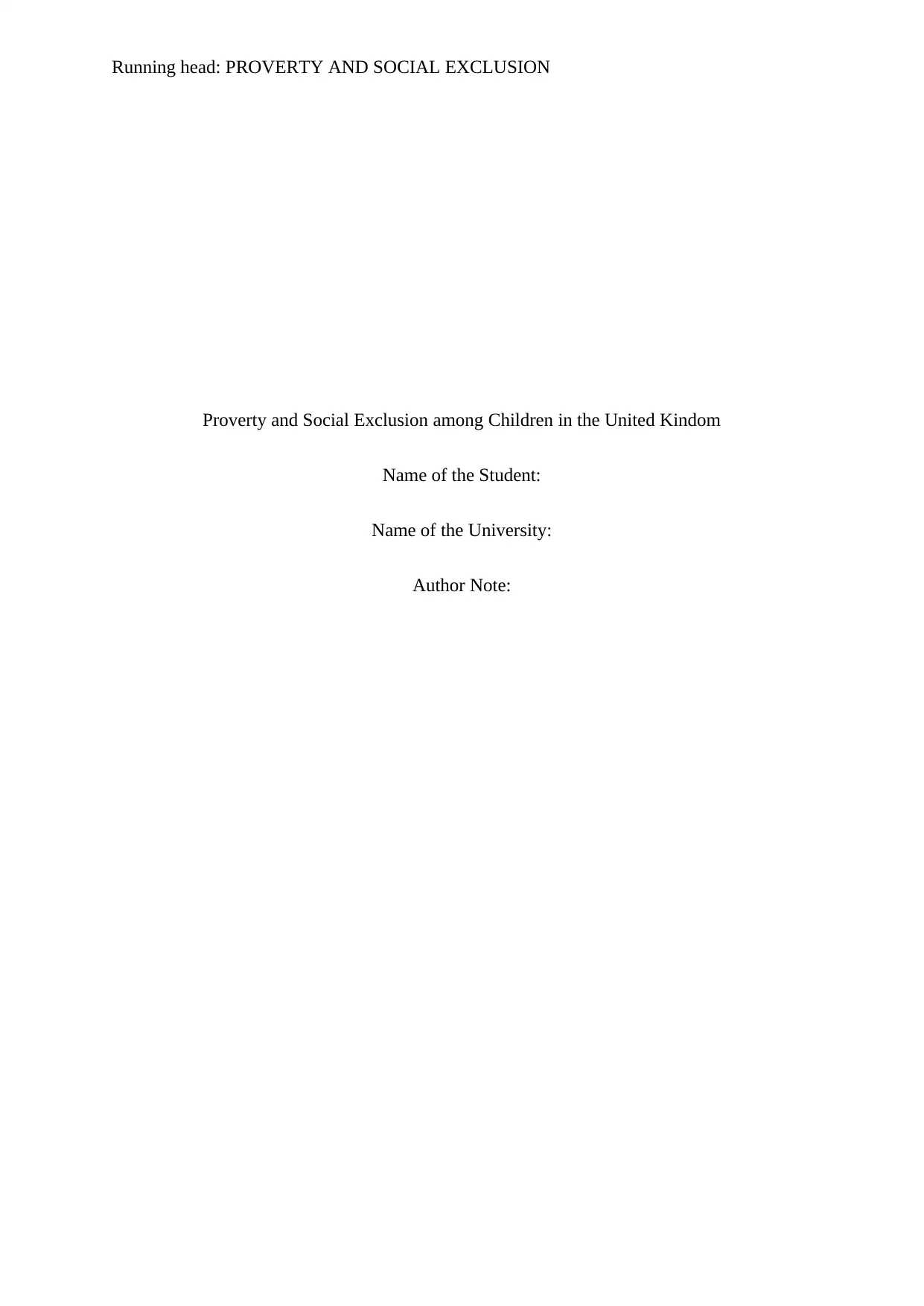
Running head: PROVERTY AND SOCIAL EXCLUSION
Proverty and Social Exclusion among Children in the United Kindom
Name of the Student:
Name of the University:
Author Note:
Proverty and Social Exclusion among Children in the United Kindom
Name of the Student:
Name of the University:
Author Note:
Paraphrase This Document
Need a fresh take? Get an instant paraphrase of this document with our AI Paraphraser
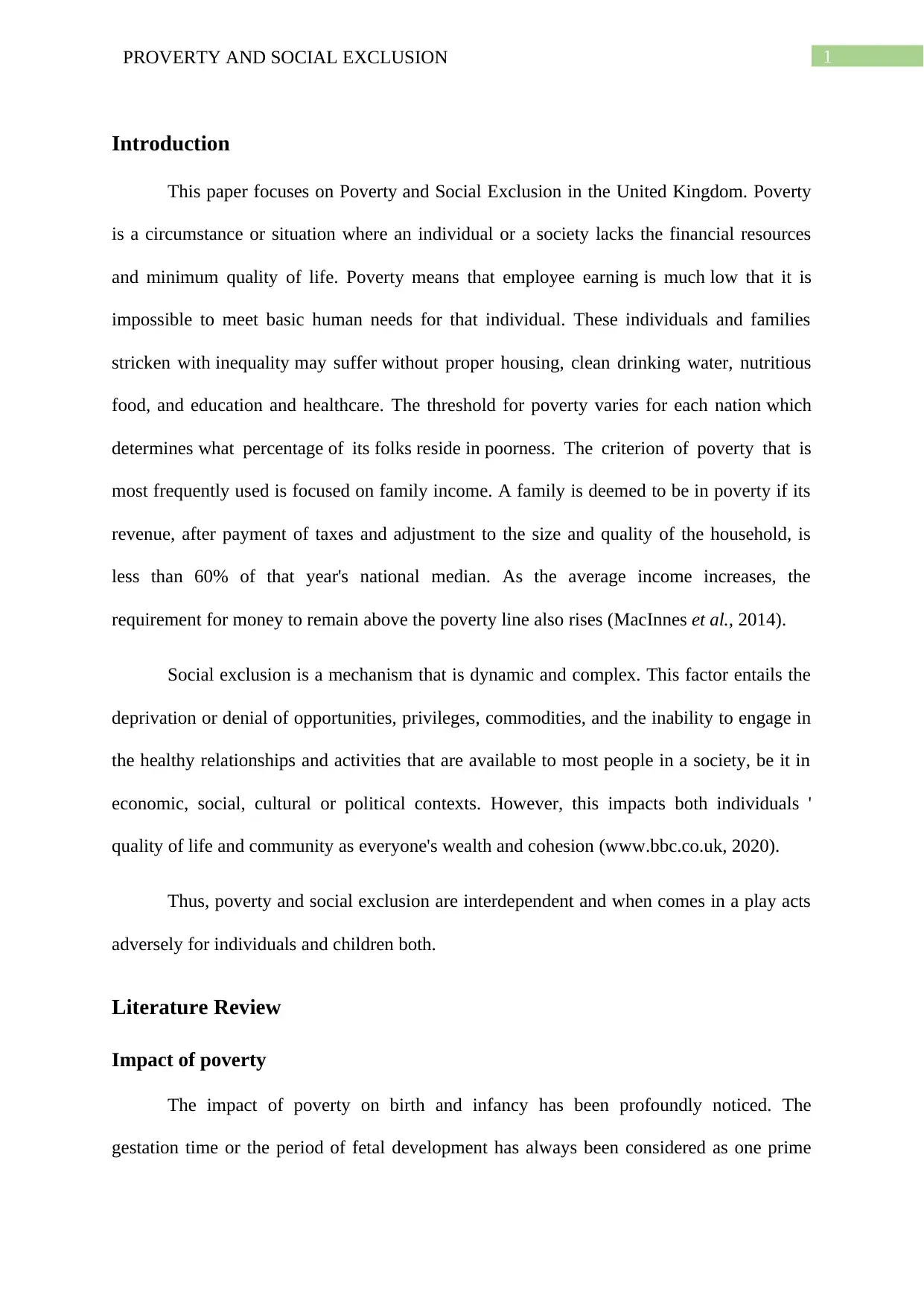
1PROVERTY AND SOCIAL EXCLUSION
Introduction
This paper focuses on Poverty and Social Exclusion in the United Kingdom. Poverty
is a circumstance or situation where an individual or a society lacks the financial resources
and minimum quality of life. Poverty means that employee earning is much low that it is
impossible to meet basic human needs for that individual. These individuals and families
stricken with inequality may suffer without proper housing, clean drinking water, nutritious
food, and education and healthcare. The threshold for poverty varies for each nation which
determines what percentage of its folks reside in poorness. The criterion of poverty that is
most frequently used is focused on family income. A family is deemed to be in poverty if its
revenue, after payment of taxes and adjustment to the size and quality of the household, is
less than 60% of that year's national median. As the average income increases, the
requirement for money to remain above the poverty line also rises (MacInnes et al., 2014).
Social exclusion is a mechanism that is dynamic and complex. This factor entails the
deprivation or denial of opportunities, privileges, commodities, and the inability to engage in
the healthy relationships and activities that are available to most people in a society, be it in
economic, social, cultural or political contexts. However, this impacts both individuals '
quality of life and community as everyone's wealth and cohesion (www.bbc.co.uk, 2020).
Thus, poverty and social exclusion are interdependent and when comes in a play acts
adversely for individuals and children both.
Literature Review
Impact of poverty
The impact of poverty on birth and infancy has been profoundly noticed. The
gestation time or the period of fetal development has always been considered as one prime
Introduction
This paper focuses on Poverty and Social Exclusion in the United Kingdom. Poverty
is a circumstance or situation where an individual or a society lacks the financial resources
and minimum quality of life. Poverty means that employee earning is much low that it is
impossible to meet basic human needs for that individual. These individuals and families
stricken with inequality may suffer without proper housing, clean drinking water, nutritious
food, and education and healthcare. The threshold for poverty varies for each nation which
determines what percentage of its folks reside in poorness. The criterion of poverty that is
most frequently used is focused on family income. A family is deemed to be in poverty if its
revenue, after payment of taxes and adjustment to the size and quality of the household, is
less than 60% of that year's national median. As the average income increases, the
requirement for money to remain above the poverty line also rises (MacInnes et al., 2014).
Social exclusion is a mechanism that is dynamic and complex. This factor entails the
deprivation or denial of opportunities, privileges, commodities, and the inability to engage in
the healthy relationships and activities that are available to most people in a society, be it in
economic, social, cultural or political contexts. However, this impacts both individuals '
quality of life and community as everyone's wealth and cohesion (www.bbc.co.uk, 2020).
Thus, poverty and social exclusion are interdependent and when comes in a play acts
adversely for individuals and children both.
Literature Review
Impact of poverty
The impact of poverty on birth and infancy has been profoundly noticed. The
gestation time or the period of fetal development has always been considered as one prime

2PROVERTY AND SOCIAL EXCLUSION
phase for the which shows significant factors which are reasonable for the development of the
new born till their puberty along with retarded cognitive health. Poverty stricken parents
often fail to provide a full period of breast milk, which attracts poor health for the new born.
Moreover, reduced birth weight, increasing mortality and morbidity rates for the newborn are
certain causes, which occur due to poverty (Strully, Rehkopf and Xuan. 2010).
Moreover, due to poverty, the infants lack a proper diet, which leads to infectious
illness for the newborn. The irregular diet also turns out to be the cause for overweight while
growing up, improper blood sugar levels, COPD, improper dental health and physical abuse
(Who.int, 2020).
Lack of Education striking the Poverty
On the other hand, education plays a tremendous part in poverty. Poverty seems as an
inheritance from generation to the other and education is one significant factor which has
contributed to the cause for a long time. Children residing in the areas deprived of
educational advantages have restricted advantages towards quality education, pre schooling
education and other extra-curricular activities. However, this leads to the formation of a
community with individuals having minimal skills and hence effecting their employment in
the future. Thus when such communities left unprivileged their newborns also remains in the
same condition as they used to be (Colclough. 2012).
Impact of Social Exclusion
Originated in the 1970s in the French Social Assistance debate, the term Social
Exclusion broadly defines as ‘collapse of Social Bonds’. The British policy has included
social exclusion as an exceptionally new term in the late 90s, which not only deals with
poverty and low income but also broadly discusses its happenings and aftereffects. Moreover,
the policy had defined the impacts over an individual or a community due to improper
phase for the which shows significant factors which are reasonable for the development of the
new born till their puberty along with retarded cognitive health. Poverty stricken parents
often fail to provide a full period of breast milk, which attracts poor health for the new born.
Moreover, reduced birth weight, increasing mortality and morbidity rates for the newborn are
certain causes, which occur due to poverty (Strully, Rehkopf and Xuan. 2010).
Moreover, due to poverty, the infants lack a proper diet, which leads to infectious
illness for the newborn. The irregular diet also turns out to be the cause for overweight while
growing up, improper blood sugar levels, COPD, improper dental health and physical abuse
(Who.int, 2020).
Lack of Education striking the Poverty
On the other hand, education plays a tremendous part in poverty. Poverty seems as an
inheritance from generation to the other and education is one significant factor which has
contributed to the cause for a long time. Children residing in the areas deprived of
educational advantages have restricted advantages towards quality education, pre schooling
education and other extra-curricular activities. However, this leads to the formation of a
community with individuals having minimal skills and hence effecting their employment in
the future. Thus when such communities left unprivileged their newborns also remains in the
same condition as they used to be (Colclough. 2012).
Impact of Social Exclusion
Originated in the 1970s in the French Social Assistance debate, the term Social
Exclusion broadly defines as ‘collapse of Social Bonds’. The British policy has included
social exclusion as an exceptionally new term in the late 90s, which not only deals with
poverty and low income but also broadly discusses its happenings and aftereffects. Moreover,
the policy had defined the impacts over an individual or a community due to improper
⊘ This is a preview!⊘
Do you want full access?
Subscribe today to unlock all pages.

Trusted by 1+ million students worldwide

3PROVERTY AND SOCIAL EXCLUSION
residencies, unemployment t, poverty, high crime rates, and breakdown of the family and
individual health (Brańka, and Skrzypczyńska. 2019).
The very first theme arises with social exclusion of children are psychiatric disorders,
mental health issues and criminality. During the decades of the 90s and mid 80s, it was
evident that child poverty has raised to an extreme limit which led to increased growth of
drug addicts and criminals among these poverty stricken children. Thus, within few months
of the implementation of the remedy to social exclusion in the British policy, a new
committee was built as Social Exclusion Unit (SEU) who were focused in examining the
cause behind such trends. Upon evaluating the trends, SEU came up with certain factors
which have contributed immensely towards such happening. These factors included children
with no Home, pregnancy during teenage, no education for the young community,
unavailability of employment and training and school exclusion (Batty, 2020).
However, it was easy to identify the causes of social exclusions and poverty. In
addition, based on the causes, plans can be easily charted, but the challenge lies in
implementing them. Moreover, it had been noticed that the overall poverty had been scattered
nationwide rather accumulating in a common geographical area. Thus, plans needed
enhancement to have an impact nationwide. The Britain Government took a new approach
towards child poverty by the year 2011 and listed several work plans that need to be
implemented. The view was towards the eradication of the poverty among the infants,
growing workforce and teenagers.
Steps were taken by HM Government
The part where the Britain Government impacted is by believing that these
communities can act as a huge source for being a workforce and hence needs to be paid back
with opportunities. Such plans showed a life changing support towards their hurdles and
residencies, unemployment t, poverty, high crime rates, and breakdown of the family and
individual health (Brańka, and Skrzypczyńska. 2019).
The very first theme arises with social exclusion of children are psychiatric disorders,
mental health issues and criminality. During the decades of the 90s and mid 80s, it was
evident that child poverty has raised to an extreme limit which led to increased growth of
drug addicts and criminals among these poverty stricken children. Thus, within few months
of the implementation of the remedy to social exclusion in the British policy, a new
committee was built as Social Exclusion Unit (SEU) who were focused in examining the
cause behind such trends. Upon evaluating the trends, SEU came up with certain factors
which have contributed immensely towards such happening. These factors included children
with no Home, pregnancy during teenage, no education for the young community,
unavailability of employment and training and school exclusion (Batty, 2020).
However, it was easy to identify the causes of social exclusions and poverty. In
addition, based on the causes, plans can be easily charted, but the challenge lies in
implementing them. Moreover, it had been noticed that the overall poverty had been scattered
nationwide rather accumulating in a common geographical area. Thus, plans needed
enhancement to have an impact nationwide. The Britain Government took a new approach
towards child poverty by the year 2011 and listed several work plans that need to be
implemented. The view was towards the eradication of the poverty among the infants,
growing workforce and teenagers.
Steps were taken by HM Government
The part where the Britain Government impacted is by believing that these
communities can act as a huge source for being a workforce and hence needs to be paid back
with opportunities. Such plans showed a life changing support towards their hurdles and
Paraphrase This Document
Need a fresh take? Get an instant paraphrase of this document with our AI Paraphraser

4PROVERTY AND SOCIAL EXCLUSION
vulnerability. It profoundly stated that those who are able to work could help their families in
providing a better quality of life if provided with education and employment.
The first step towards ensuring the policy was by developing employment
opportunities, which can help a family to push themselves out of poverty. Thus the
community which stayed deprived of quality life can put an effort in enhancing quality life
for their children. The second most crucial implementation was providing education. The
plan was implemented to reduce barrier in educational attainment. The strategy was
implemented by the use of including Pupil Premium and Strategy towards social mobility (A
New Approach to Child Poverty: Tackling the Causes of Disadvantage and Transforming
Families’ Lives, 2020).
These strategies helped in preventing generations to overcome certain barriers that
were once faced by their ancestors. Thus, the cycle of deprivation can be challenged and
eradicated from society as well (Coburn, and Gormally., 2019).
Putting impact through Transformational Leadership
The most important culture that can be implemented is the introduction of a
transformational leader towards enhancing the education for such communities, regarding the
health and the cycle of deprivation, that is being continued since ages. Such leadership
strategies help in positive motivation for the followers which leads thinking of the better
quality of life for the community as well as the teenagers. Moreover, a transformational
leader can put impact over the thinking of these children by setting up examples of how
education and employment can effect in enhancing their status of life (Smith, 2020).
vulnerability. It profoundly stated that those who are able to work could help their families in
providing a better quality of life if provided with education and employment.
The first step towards ensuring the policy was by developing employment
opportunities, which can help a family to push themselves out of poverty. Thus the
community which stayed deprived of quality life can put an effort in enhancing quality life
for their children. The second most crucial implementation was providing education. The
plan was implemented to reduce barrier in educational attainment. The strategy was
implemented by the use of including Pupil Premium and Strategy towards social mobility (A
New Approach to Child Poverty: Tackling the Causes of Disadvantage and Transforming
Families’ Lives, 2020).
These strategies helped in preventing generations to overcome certain barriers that
were once faced by their ancestors. Thus, the cycle of deprivation can be challenged and
eradicated from society as well (Coburn, and Gormally., 2019).
Putting impact through Transformational Leadership
The most important culture that can be implemented is the introduction of a
transformational leader towards enhancing the education for such communities, regarding the
health and the cycle of deprivation, that is being continued since ages. Such leadership
strategies help in positive motivation for the followers which leads thinking of the better
quality of life for the community as well as the teenagers. Moreover, a transformational
leader can put impact over the thinking of these children by setting up examples of how
education and employment can effect in enhancing their status of life (Smith, 2020).
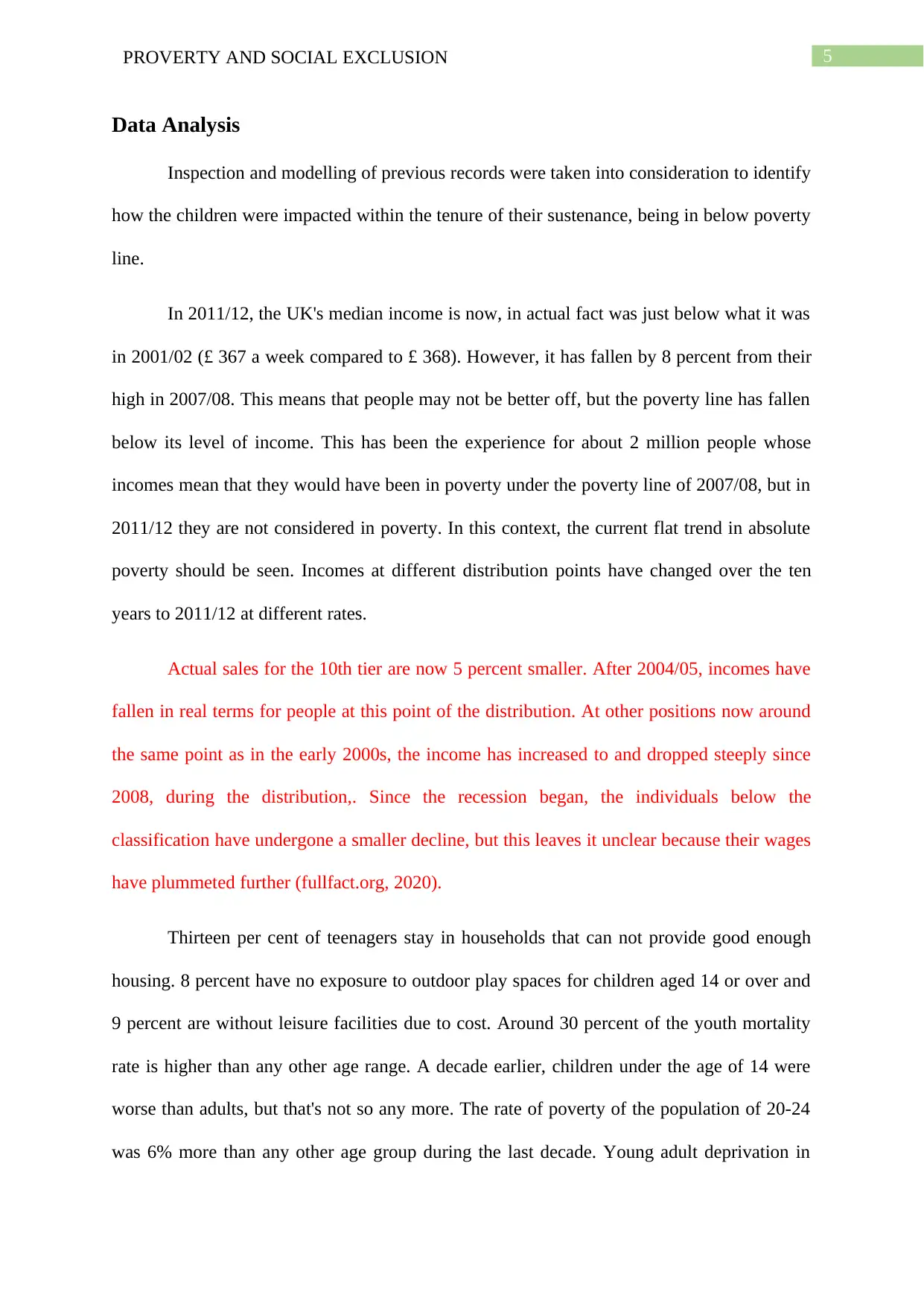
5PROVERTY AND SOCIAL EXCLUSION
Data Analysis
Inspection and modelling of previous records were taken into consideration to identify
how the children were impacted within the tenure of their sustenance, being in below poverty
line.
In 2011/12, the UK's median income is now, in actual fact was just below what it was
in 2001/02 (£ 367 a week compared to £ 368). However, it has fallen by 8 percent from their
high in 2007/08. This means that people may not be better off, but the poverty line has fallen
below its level of income. This has been the experience for about 2 million people whose
incomes mean that they would have been in poverty under the poverty line of 2007/08, but in
2011/12 they are not considered in poverty. In this context, the current flat trend in absolute
poverty should be seen. Incomes at different distribution points have changed over the ten
years to 2011/12 at different rates.
Actual sales for the 10th tier are now 5 percent smaller. After 2004/05, incomes have
fallen in real terms for people at this point of the distribution. At other positions now around
the same point as in the early 2000s, the income has increased to and dropped steeply since
2008, during the distribution,. Since the recession began, the individuals below the
classification have undergone a smaller decline, but this leaves it unclear because their wages
have plummeted further (fullfact.org, 2020).
Thirteen per cent of teenagers stay in households that can not provide good enough
housing. 8 percent have no exposure to outdoor play spaces for children aged 14 or over and
9 percent are without leisure facilities due to cost. Around 30 percent of the youth mortality
rate is higher than any other age range. A decade earlier, children under the age of 14 were
worse than adults, but that's not so any more. The rate of poverty of the population of 20-24
was 6% more than any other age group during the last decade. Young adult deprivation in
Data Analysis
Inspection and modelling of previous records were taken into consideration to identify
how the children were impacted within the tenure of their sustenance, being in below poverty
line.
In 2011/12, the UK's median income is now, in actual fact was just below what it was
in 2001/02 (£ 367 a week compared to £ 368). However, it has fallen by 8 percent from their
high in 2007/08. This means that people may not be better off, but the poverty line has fallen
below its level of income. This has been the experience for about 2 million people whose
incomes mean that they would have been in poverty under the poverty line of 2007/08, but in
2011/12 they are not considered in poverty. In this context, the current flat trend in absolute
poverty should be seen. Incomes at different distribution points have changed over the ten
years to 2011/12 at different rates.
Actual sales for the 10th tier are now 5 percent smaller. After 2004/05, incomes have
fallen in real terms for people at this point of the distribution. At other positions now around
the same point as in the early 2000s, the income has increased to and dropped steeply since
2008, during the distribution,. Since the recession began, the individuals below the
classification have undergone a smaller decline, but this leaves it unclear because their wages
have plummeted further (fullfact.org, 2020).
Thirteen per cent of teenagers stay in households that can not provide good enough
housing. 8 percent have no exposure to outdoor play spaces for children aged 14 or over and
9 percent are without leisure facilities due to cost. Around 30 percent of the youth mortality
rate is higher than any other age range. A decade earlier, children under the age of 14 were
worse than adults, but that's not so any more. The rate of poverty of the population of 20-24
was 6% more than any other age group during the last decade. Young adult deprivation in
⊘ This is a preview!⊘
Do you want full access?
Subscribe today to unlock all pages.

Trusted by 1+ million students worldwide
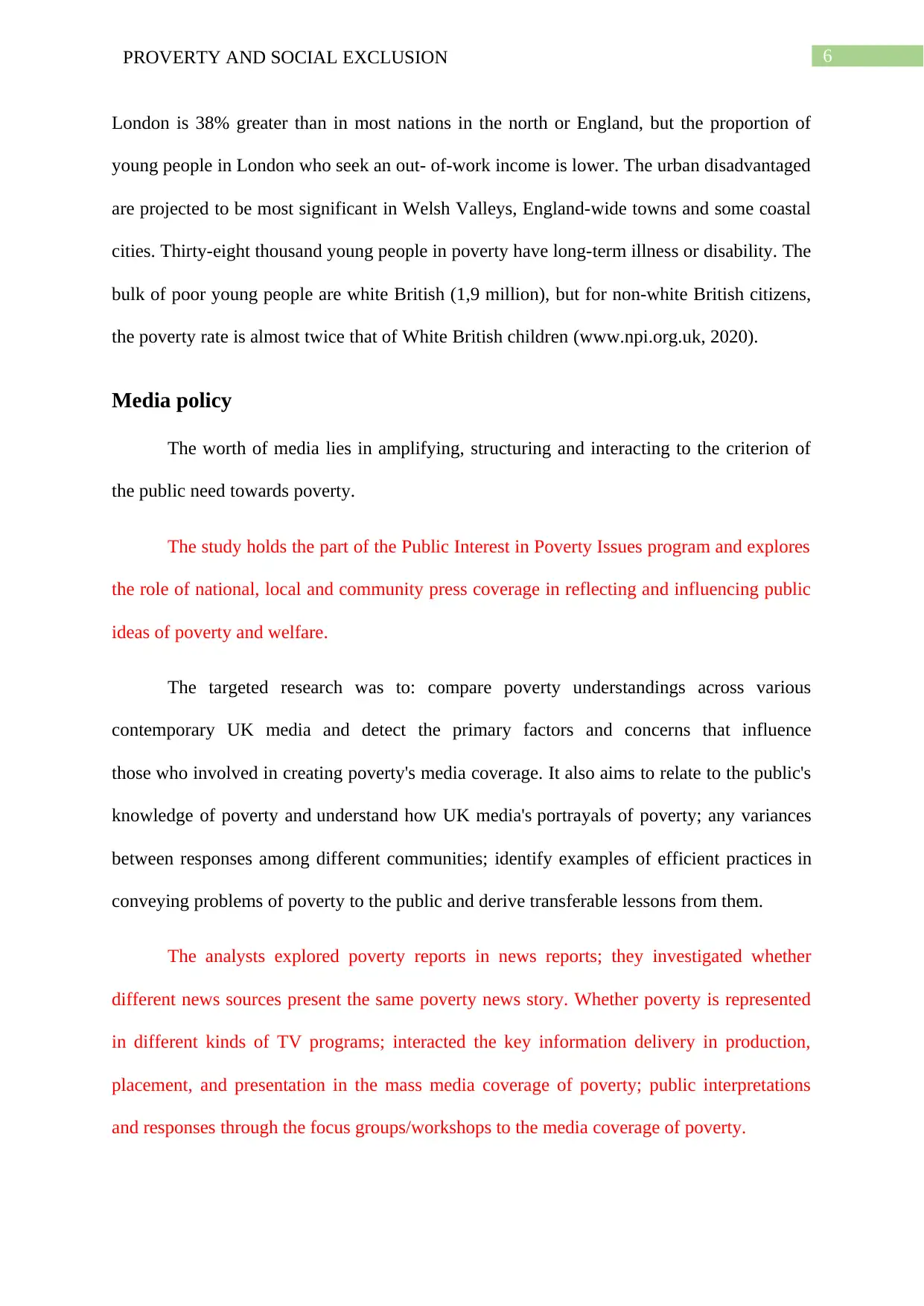
6PROVERTY AND SOCIAL EXCLUSION
London is 38% greater than in most nations in the north or England, but the proportion of
young people in London who seek an out- of-work income is lower. The urban disadvantaged
are projected to be most significant in Welsh Valleys, England-wide towns and some coastal
cities. Thirty-eight thousand young people in poverty have long-term illness or disability. The
bulk of poor young people are white British (1,9 million), but for non-white British citizens,
the poverty rate is almost twice that of White British children (www.npi.org.uk, 2020).
Media policy
The worth of media lies in amplifying, structuring and interacting to the criterion of
the public need towards poverty.
The study holds the part of the Public Interest in Poverty Issues program and explores
the role of national, local and community press coverage in reflecting and influencing public
ideas of poverty and welfare.
The targeted research was to: compare poverty understandings across various
contemporary UK media and detect the primary factors and concerns that influence
those who involved in creating poverty's media coverage. It also aims to relate to the public's
knowledge of poverty and understand how UK media's portrayals of poverty; any variances
between responses among different communities; identify examples of efficient practices in
conveying problems of poverty to the public and derive transferable lessons from them.
The analysts explored poverty reports in news reports; they investigated whether
different news sources present the same poverty news story. Whether poverty is represented
in different kinds of TV programs; interacted the key information delivery in production,
placement, and presentation in the mass media coverage of poverty; public interpretations
and responses through the focus groups/workshops to the media coverage of poverty.
London is 38% greater than in most nations in the north or England, but the proportion of
young people in London who seek an out- of-work income is lower. The urban disadvantaged
are projected to be most significant in Welsh Valleys, England-wide towns and some coastal
cities. Thirty-eight thousand young people in poverty have long-term illness or disability. The
bulk of poor young people are white British (1,9 million), but for non-white British citizens,
the poverty rate is almost twice that of White British children (www.npi.org.uk, 2020).
Media policy
The worth of media lies in amplifying, structuring and interacting to the criterion of
the public need towards poverty.
The study holds the part of the Public Interest in Poverty Issues program and explores
the role of national, local and community press coverage in reflecting and influencing public
ideas of poverty and welfare.
The targeted research was to: compare poverty understandings across various
contemporary UK media and detect the primary factors and concerns that influence
those who involved in creating poverty's media coverage. It also aims to relate to the public's
knowledge of poverty and understand how UK media's portrayals of poverty; any variances
between responses among different communities; identify examples of efficient practices in
conveying problems of poverty to the public and derive transferable lessons from them.
The analysts explored poverty reports in news reports; they investigated whether
different news sources present the same poverty news story. Whether poverty is represented
in different kinds of TV programs; interacted the key information delivery in production,
placement, and presentation in the mass media coverage of poverty; public interpretations
and responses through the focus groups/workshops to the media coverage of poverty.
Paraphrase This Document
Need a fresh take? Get an instant paraphrase of this document with our AI Paraphraser
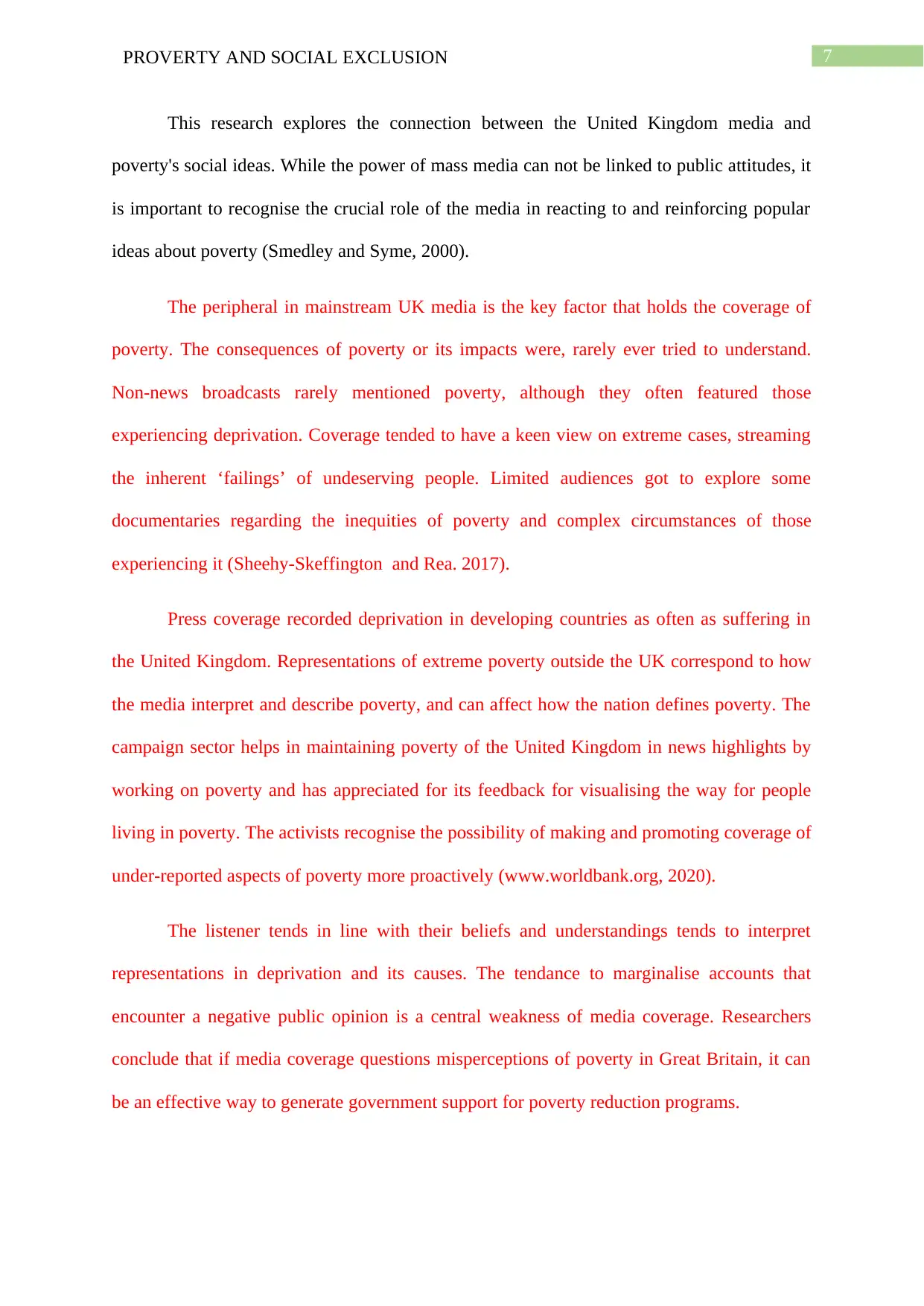
7PROVERTY AND SOCIAL EXCLUSION
This research explores the connection between the United Kingdom media and
poverty's social ideas. While the power of mass media can not be linked to public attitudes, it
is important to recognise the crucial role of the media in reacting to and reinforcing popular
ideas about poverty (Smedley and Syme, 2000).
The peripheral in mainstream UK media is the key factor that holds the coverage of
poverty. The consequences of poverty or its impacts were, rarely ever tried to understand.
Non-news broadcasts rarely mentioned poverty, although they often featured those
experiencing deprivation. Coverage tended to have a keen view on extreme cases, streaming
the inherent ‘failings’ of undeserving people. Limited audiences got to explore some
documentaries regarding the inequities of poverty and complex circumstances of those
experiencing it (Sheehy-Skeffington and Rea. 2017).
Press coverage recorded deprivation in developing countries as often as suffering in
the United Kingdom. Representations of extreme poverty outside the UK correspond to how
the media interpret and describe poverty, and can affect how the nation defines poverty. The
campaign sector helps in maintaining poverty of the United Kingdom in news highlights by
working on poverty and has appreciated for its feedback for visualising the way for people
living in poverty. The activists recognise the possibility of making and promoting coverage of
under-reported aspects of poverty more proactively (www.worldbank.org, 2020).
The listener tends in line with their beliefs and understandings tends to interpret
representations in deprivation and its causes. The tendance to marginalise accounts that
encounter a negative public opinion is a central weakness of media coverage. Researchers
conclude that if media coverage questions misperceptions of poverty in Great Britain, it can
be an effective way to generate government support for poverty reduction programs.
This research explores the connection between the United Kingdom media and
poverty's social ideas. While the power of mass media can not be linked to public attitudes, it
is important to recognise the crucial role of the media in reacting to and reinforcing popular
ideas about poverty (Smedley and Syme, 2000).
The peripheral in mainstream UK media is the key factor that holds the coverage of
poverty. The consequences of poverty or its impacts were, rarely ever tried to understand.
Non-news broadcasts rarely mentioned poverty, although they often featured those
experiencing deprivation. Coverage tended to have a keen view on extreme cases, streaming
the inherent ‘failings’ of undeserving people. Limited audiences got to explore some
documentaries regarding the inequities of poverty and complex circumstances of those
experiencing it (Sheehy-Skeffington and Rea. 2017).
Press coverage recorded deprivation in developing countries as often as suffering in
the United Kingdom. Representations of extreme poverty outside the UK correspond to how
the media interpret and describe poverty, and can affect how the nation defines poverty. The
campaign sector helps in maintaining poverty of the United Kingdom in news highlights by
working on poverty and has appreciated for its feedback for visualising the way for people
living in poverty. The activists recognise the possibility of making and promoting coverage of
under-reported aspects of poverty more proactively (www.worldbank.org, 2020).
The listener tends in line with their beliefs and understandings tends to interpret
representations in deprivation and its causes. The tendance to marginalise accounts that
encounter a negative public opinion is a central weakness of media coverage. Researchers
conclude that if media coverage questions misperceptions of poverty in Great Britain, it can
be an effective way to generate government support for poverty reduction programs.
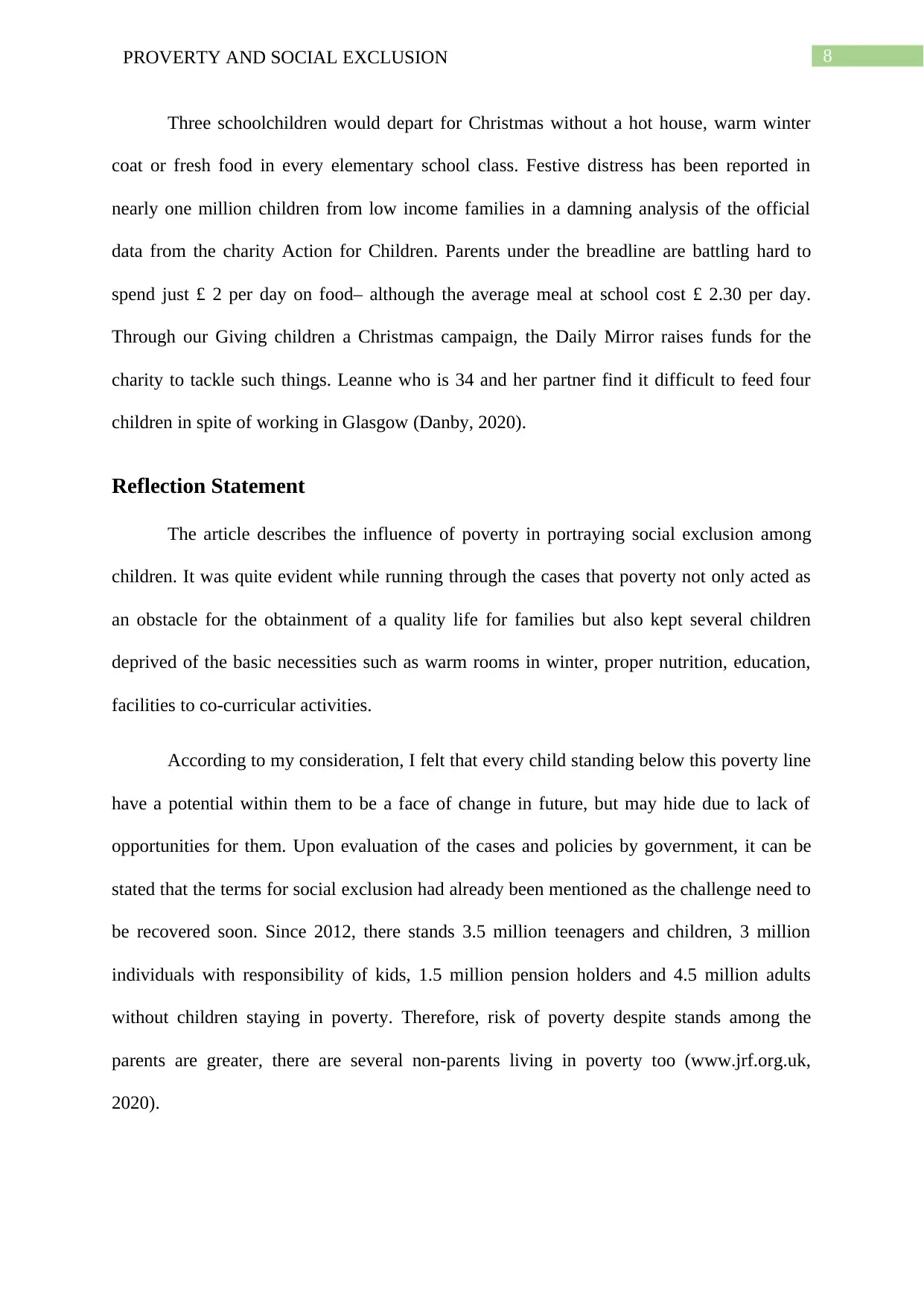
8PROVERTY AND SOCIAL EXCLUSION
Three schoolchildren would depart for Christmas without a hot house, warm winter
coat or fresh food in every elementary school class. Festive distress has been reported in
nearly one million children from low income families in a damning analysis of the official
data from the charity Action for Children. Parents under the breadline are battling hard to
spend just £ 2 per day on food– although the average meal at school cost £ 2.30 per day.
Through our Giving children a Christmas campaign, the Daily Mirror raises funds for the
charity to tackle such things. Leanne who is 34 and her partner find it difficult to feed four
children in spite of working in Glasgow (Danby, 2020).
Reflection Statement
The article describes the influence of poverty in portraying social exclusion among
children. It was quite evident while running through the cases that poverty not only acted as
an obstacle for the obtainment of a quality life for families but also kept several children
deprived of the basic necessities such as warm rooms in winter, proper nutrition, education,
facilities to co-curricular activities.
According to my consideration, I felt that every child standing below this poverty line
have a potential within them to be a face of change in future, but may hide due to lack of
opportunities for them. Upon evaluation of the cases and policies by government, it can be
stated that the terms for social exclusion had already been mentioned as the challenge need to
be recovered soon. Since 2012, there stands 3.5 million teenagers and children, 3 million
individuals with responsibility of kids, 1.5 million pension holders and 4.5 million adults
without children staying in poverty. Therefore, risk of poverty despite stands among the
parents are greater, there are several non-parents living in poverty too (www.jrf.org.uk,
2020).
Three schoolchildren would depart for Christmas without a hot house, warm winter
coat or fresh food in every elementary school class. Festive distress has been reported in
nearly one million children from low income families in a damning analysis of the official
data from the charity Action for Children. Parents under the breadline are battling hard to
spend just £ 2 per day on food– although the average meal at school cost £ 2.30 per day.
Through our Giving children a Christmas campaign, the Daily Mirror raises funds for the
charity to tackle such things. Leanne who is 34 and her partner find it difficult to feed four
children in spite of working in Glasgow (Danby, 2020).
Reflection Statement
The article describes the influence of poverty in portraying social exclusion among
children. It was quite evident while running through the cases that poverty not only acted as
an obstacle for the obtainment of a quality life for families but also kept several children
deprived of the basic necessities such as warm rooms in winter, proper nutrition, education,
facilities to co-curricular activities.
According to my consideration, I felt that every child standing below this poverty line
have a potential within them to be a face of change in future, but may hide due to lack of
opportunities for them. Upon evaluation of the cases and policies by government, it can be
stated that the terms for social exclusion had already been mentioned as the challenge need to
be recovered soon. Since 2012, there stands 3.5 million teenagers and children, 3 million
individuals with responsibility of kids, 1.5 million pension holders and 4.5 million adults
without children staying in poverty. Therefore, risk of poverty despite stands among the
parents are greater, there are several non-parents living in poverty too (www.jrf.org.uk,
2020).
⊘ This is a preview!⊘
Do you want full access?
Subscribe today to unlock all pages.

Trusted by 1+ million students worldwide
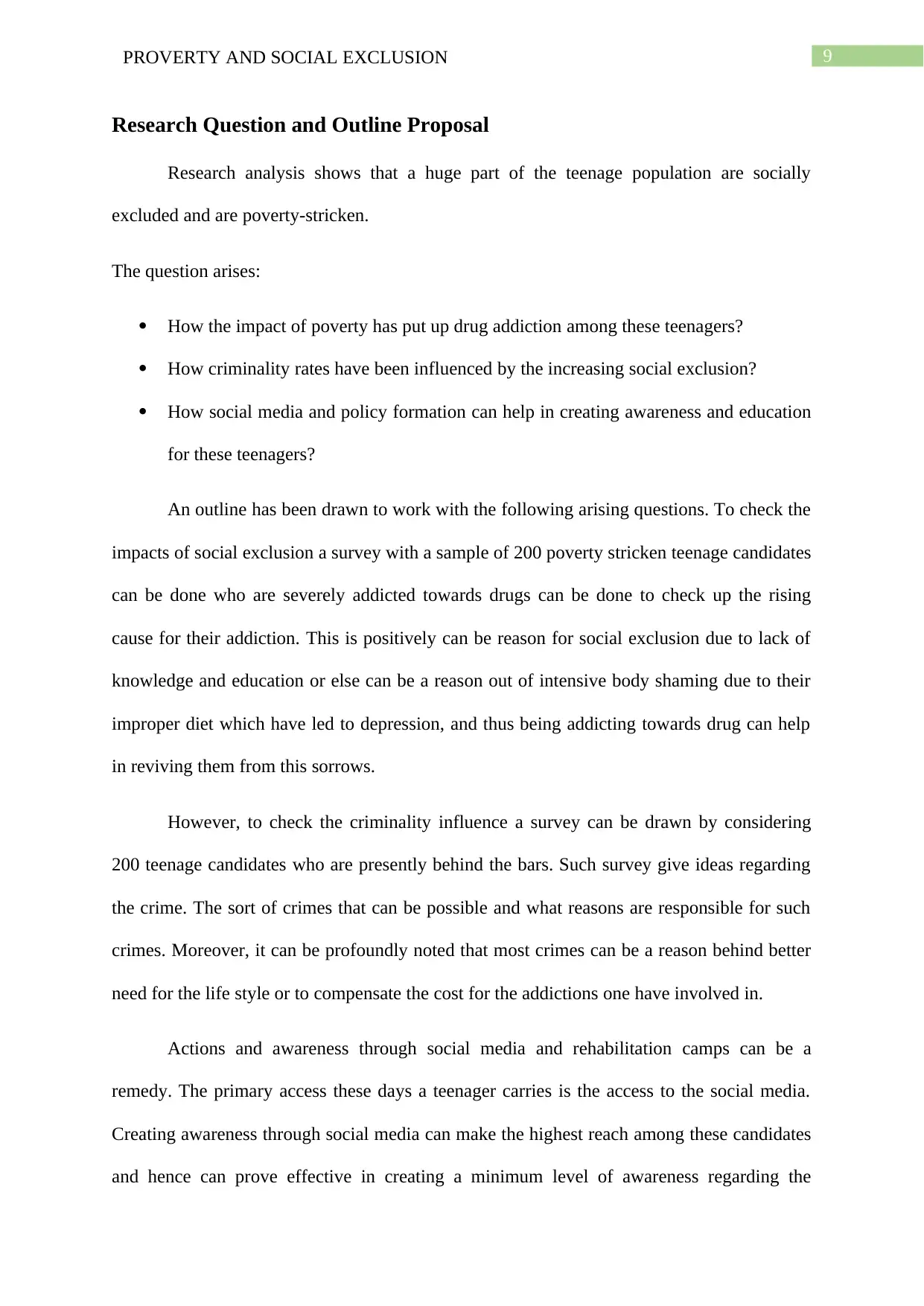
9PROVERTY AND SOCIAL EXCLUSION
Research Question and Outline Proposal
Research analysis shows that a huge part of the teenage population are socially
excluded and are poverty-stricken.
The question arises:
How the impact of poverty has put up drug addiction among these teenagers?
How criminality rates have been influenced by the increasing social exclusion?
How social media and policy formation can help in creating awareness and education
for these teenagers?
An outline has been drawn to work with the following arising questions. To check the
impacts of social exclusion a survey with a sample of 200 poverty stricken teenage candidates
can be done who are severely addicted towards drugs can be done to check up the rising
cause for their addiction. This is positively can be reason for social exclusion due to lack of
knowledge and education or else can be a reason out of intensive body shaming due to their
improper diet which have led to depression, and thus being addicting towards drug can help
in reviving them from this sorrows.
However, to check the criminality influence a survey can be drawn by considering
200 teenage candidates who are presently behind the bars. Such survey give ideas regarding
the crime. The sort of crimes that can be possible and what reasons are responsible for such
crimes. Moreover, it can be profoundly noted that most crimes can be a reason behind better
need for the life style or to compensate the cost for the addictions one have involved in.
Actions and awareness through social media and rehabilitation camps can be a
remedy. The primary access these days a teenager carries is the access to the social media.
Creating awareness through social media can make the highest reach among these candidates
and hence can prove effective in creating a minimum level of awareness regarding the
Research Question and Outline Proposal
Research analysis shows that a huge part of the teenage population are socially
excluded and are poverty-stricken.
The question arises:
How the impact of poverty has put up drug addiction among these teenagers?
How criminality rates have been influenced by the increasing social exclusion?
How social media and policy formation can help in creating awareness and education
for these teenagers?
An outline has been drawn to work with the following arising questions. To check the
impacts of social exclusion a survey with a sample of 200 poverty stricken teenage candidates
can be done who are severely addicted towards drugs can be done to check up the rising
cause for their addiction. This is positively can be reason for social exclusion due to lack of
knowledge and education or else can be a reason out of intensive body shaming due to their
improper diet which have led to depression, and thus being addicting towards drug can help
in reviving them from this sorrows.
However, to check the criminality influence a survey can be drawn by considering
200 teenage candidates who are presently behind the bars. Such survey give ideas regarding
the crime. The sort of crimes that can be possible and what reasons are responsible for such
crimes. Moreover, it can be profoundly noted that most crimes can be a reason behind better
need for the life style or to compensate the cost for the addictions one have involved in.
Actions and awareness through social media and rehabilitation camps can be a
remedy. The primary access these days a teenager carries is the access to the social media.
Creating awareness through social media can make the highest reach among these candidates
and hence can prove effective in creating a minimum level of awareness regarding the
Paraphrase This Document
Need a fresh take? Get an instant paraphrase of this document with our AI Paraphraser

10PROVERTY AND SOCIAL EXCLUSION
harmful causes of the drugs and how inadequate nutrition has stricken the population towards
cognitive illness. Moreover, such awareness can bring up the concern regarding what an
individual faces upon indulging himself or herself with the act of criminality.
Providing services by community based rehabilitation centers can also be the other
remedy towards the control of drug addiction and criminality rates among the youth. These
centers help in understanding and helps them to seek methods in achieving a better quality of
life. However, introduction of a policies by government and holding them up with help of a
transformational leader can also impact in improving quality of living standard for those who
are residing in geographically excluded and poverty stricken areas.
These social transformational leaders must be authentic and must have good
knowledge to turn the attention of the mob towards them. Supply of certain examples
regarding improvement of social and economic status can prove impact on an individual’s
thinking process. In addition, these leaders can also put up examples of the cycle of
deprivation that had been in a process since their ancestral past.
Conclusion
Therefore, it can be concluded, that poverty is a circumstance in which the finances
and basic standard of living are insufficient for a person or community. Social exclusion is a
fluid, potent toxin. This aspect means that most people of a community, whether economic,
financial, cultural or political, are deprived of or denied opportunities, rights, amenities and
the inability to engage in safe relations and practices.
These issues had been a part of the British society for a long time and hence
demanded for adequate remedial measures. The government has already settled up certain
harmful causes of the drugs and how inadequate nutrition has stricken the population towards
cognitive illness. Moreover, such awareness can bring up the concern regarding what an
individual faces upon indulging himself or herself with the act of criminality.
Providing services by community based rehabilitation centers can also be the other
remedy towards the control of drug addiction and criminality rates among the youth. These
centers help in understanding and helps them to seek methods in achieving a better quality of
life. However, introduction of a policies by government and holding them up with help of a
transformational leader can also impact in improving quality of living standard for those who
are residing in geographically excluded and poverty stricken areas.
These social transformational leaders must be authentic and must have good
knowledge to turn the attention of the mob towards them. Supply of certain examples
regarding improvement of social and economic status can prove impact on an individual’s
thinking process. In addition, these leaders can also put up examples of the cycle of
deprivation that had been in a process since their ancestral past.
Conclusion
Therefore, it can be concluded, that poverty is a circumstance in which the finances
and basic standard of living are insufficient for a person or community. Social exclusion is a
fluid, potent toxin. This aspect means that most people of a community, whether economic,
financial, cultural or political, are deprived of or denied opportunities, rights, amenities and
the inability to engage in safe relations and practices.
These issues had been a part of the British society for a long time and hence
demanded for adequate remedial measures. The government has already settled up certain

11PROVERTY AND SOCIAL EXCLUSION
policies and framework for the enhancement of the eradication of youth poverty and hence a
trial towards providing a quality life for the socially deprived community has been initiated.
The media holds the ability to educate the public about the existence of poverty,
and poverty can be humanised and politicised. This probability is compromised, however, as
poverty is hardly ever defined directly. Sensationalism is not justified by the evidence from
focus groups about which coverage is most memorable. Rather, it demonstrates that it can be
efficient to cover which challenges the audience.
An analysis through past data has also been done to identify the probable changes in
the poverty line since the past, and thus the approach can be estimated. On the other hand,
surveys were generated to understand and to plan down probable outcomes for the cause. The
plan was to have an idea for the criminality rates and drug addiction among the youths and
also to implement transformational leadership in order to turn the mindset of the affected
individuals.
policies and framework for the enhancement of the eradication of youth poverty and hence a
trial towards providing a quality life for the socially deprived community has been initiated.
The media holds the ability to educate the public about the existence of poverty,
and poverty can be humanised and politicised. This probability is compromised, however, as
poverty is hardly ever defined directly. Sensationalism is not justified by the evidence from
focus groups about which coverage is most memorable. Rather, it demonstrates that it can be
efficient to cover which challenges the audience.
An analysis through past data has also been done to identify the probable changes in
the poverty line since the past, and thus the approach can be estimated. On the other hand,
surveys were generated to understand and to plan down probable outcomes for the cause. The
plan was to have an idea for the criminality rates and drug addiction among the youths and
also to implement transformational leadership in order to turn the mindset of the affected
individuals.
⊘ This is a preview!⊘
Do you want full access?
Subscribe today to unlock all pages.

Trusted by 1+ million students worldwide
1 out of 14
Related Documents
Your All-in-One AI-Powered Toolkit for Academic Success.
+13062052269
info@desklib.com
Available 24*7 on WhatsApp / Email
![[object Object]](/_next/static/media/star-bottom.7253800d.svg)
Unlock your academic potential
Copyright © 2020–2025 A2Z Services. All Rights Reserved. Developed and managed by ZUCOL.





